The global inductance meters market, valued at USD 1,489.1 million in 2025 and expected to reach USD 2,379.7 million by 2035, expanding at a CAGR of 4.8%, is witnessing significant innovation trends that are reshaping the precision testing and measurement space. Instrument manufacturers are moving toward the development of compact, multifunctional, and highly automated solutions that support both R&D laboratories and large-scale industrial quality control. One of the most visible trends is the integration of inductance meters with advanced software ecosystems that enable real-time data logging, wireless connectivity, and cloud-based analytics. This shift allows seamless monitoring of component performance, predictive failure analysis, and integration with enterprise resource planning systems in electronics and power industries.
Another key innovation is the convergence of inductance meters with LCR meters and broader multifunctional test devices. Manufacturers are embedding inductance measurement into portable and benchtop systems that can simultaneously handle resistance, capacitance, impedance, and quality factor testing. This convergence not only enhances efficiency but also reduces the overall cost of ownership for laboratories and industrial facilities, especially in the electronics and EV powertrain sectors. Miniaturization is also emerging as an important trend, with handheld meters becoming more advanced, offering high precision, automated calibration, and user-friendly interfaces, making them suitable for both field engineers and technicians in education and industrial repair operations.
Artificial intelligence and automation are further pushing the boundaries of inductance testing. AI-driven fault detection is increasingly being embedded in inductance meters, enabling real-time error identification in complex circuits. Automated calibration processes, machine learning algorithms for data optimization, and robotics integration for in-line production testing are also advancing. This trend is particularly relevant for electronics assembly lines in Asia Pacific, where inductance meters are becoming part of high-speed, automated quality control systems.
In parallel, manufacturers are focusing on energy efficiency and environmental considerations. Low-power consumption meters and eco-friendly designs are gaining traction, especially in regions where energy efficiency standards are tightening. The growing EV and renewable energy markets are driving the demand for inductance meters capable of testing components such as inverters, converters, and motor coils under high-frequency and high-voltage conditions, prompting innovation in ruggedized, high-performance meters.
Between 2025 and 2030, the inductance meters market is projected to expand from USD 1,489.1 million to USD 1,835.6 million, resulting in a value increase of USD 346.5 million, which represents 38.9% of the total forecast growth for the decade. This phase of development will be shaped by increasing adoption of precision measurement technologies, rising demand for high-accuracy testing instruments, and growing emphasis on automated measurement systems with enhanced calibration characteristics. Electronics manufacturers are expanding their testing capabilities to address the growing demand for component verification, quality assurance protocols, and advanced circuit analysis requirements.
| Metric | Value |
|---|---|
| Estimated Value in (2025E) | USD 1,489.1 million |
| Forecast Value in (2035F) | USD 2,379.7 million |
| Forecast CAGR (2025 to 2035) | 4.8% |
From 2030 to 2035, the market is forecast to grow from USD 1,835.6 million to USD 2,379.7 million, adding another USD 544.1 million, which constitutes 61.1% of the overall ten-year expansion. This period is expected to be characterized by the expansion of digital measurement technologies, the integration of IoT-enabled testing systems, and the development of multi-functional meter platforms with enhanced precision capabilities. The growing adoption of smart manufacturing practices will drive demand for inductance meters with superior data connectivity and compatibility with manufacturing execution systems across industrial operations.
Between 2020 and 2025, the inductance meters market experienced steady growth, driven by increasing demand for precision electronics testing and growing recognition of measurement accuracy as essential requirement for quality control across component manufacturing, research laboratories, and power electronics applications. The inductance meters market developed as engineers recognized the potential for advanced meters to improve measurement reliability while maintaining testing efficiency and enabling comprehensive component characterization protocols. Technological advancement in digital signal processing and automated measurement techniques began emphasizing the critical importance of maintaining precision accuracy and measurement repeatability in diverse testing environments.
Market expansion is being supported by the increasing global demand for precision measurement solutions and the corresponding need for automated systems that can provide superior measurement accuracy and testing efficiency while enabling comprehensive component characterization and quality verification across various electronics manufacturing and laboratory research applications. Modern electronics manufacturers and testing specialists are increasingly focused on implementing measurement technologies that can deliver accurate inductance values, prevent measurement errors, and provide consistent testing performance throughout complex component evaluation and production quality control. Inductance meters' proven ability to deliver exceptional precision for component analysis, enable time-efficient testing operations, and support cost-effective measurement protocols make them essential tools for contemporary electronics manufacturing and laboratory operations.
The growing emphasis on electronics quality and manufacturing precision is driving demand for inductance meters that can support high-volume production requirements, improve measurement accuracy outcomes, and enable automated testing systems. Engineers' preference for technology that combines effective component characterization with operational speed and measurement reliability is creating opportunities for innovative meter implementations. The rising influence of smart manufacturing and Industry 4.0 practices is also contributing to increased demand for inductance meters that can provide networked measurements, real-time monitoring capabilities, and reliable performance across extended testing periods.
The inductance meters market is poised for steady growth and technological advancement. As industries across electronics manufacturing, automotive, aerospace, and research laboratories seek solutions that deliver exceptional measurement precision, operational efficiency, and testing reliability, inductance meters are gaining prominence not just as specialized instruments but as strategic enablers of modern quality control practices and component verification.
Rising electronics manufacturing growth in Asia-Pacific and expanding smart manufacturing initiatives globally amplify demand, while manufacturers are leveraging innovations in digital measurement systems, automated testing platforms, and integrated data management technologies.
Pathways like high-precision measurement platforms, IoT-enabled testing systems, and specialized application solutions promise strong margin uplift, especially in automotive electronics and aerospace segments. Geographic expansion and technology integration will capture volume, particularly where local manufacturing practices and precision testing adoption are critical. Regulatory support around electronics standards compliance, measurement accuracy requirements, and quality control standards give structural support.
The inductance meters market is segmented by type, application, end-use sector, frequency range, and region. By type, the inductance meters market is divided into desktop and handheld categories. By application, it covers power industry, laboratory, and others. By end-use sector, it is categorized into electronics manufacturing, research institutions, automotive, aerospace, and telecommunications. By frequency range, it includes low frequency (20Hz-100kHz), medium frequency (100kHz-1MHz), and high frequency (1MHz-10MHz). Regionally, the market is divided into North America, Europe, East Asia, South Asia & Pacific, Latin America, and the Middle East & Africa.
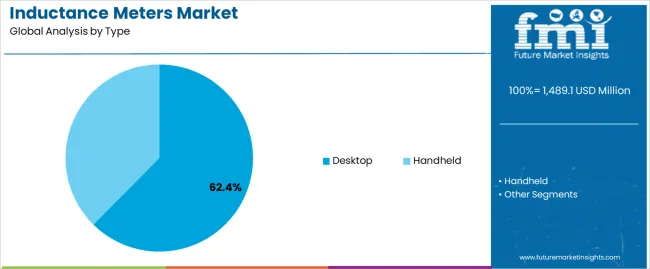
The desktop segment is projected to account for 62.4% of the inductance meters market in 2025, reaffirming its position as the leading type category. Electronics manufacturing facilities and research laboratories increasingly utilize desktop inductance meters for their superior measurement precision capabilities when operating in controlled testing environments, excellent stability characteristics, and cost-effectiveness in applications ranging from component verification to advanced research measurement requirements. Desktop inductance meter technology's advanced measurement system capabilities and enhanced accuracy specifications directly address the industrial requirements for comprehensive testing in laboratory and manufacturing environments.
This type segment forms the foundation of modern electronics testing operations, as it represents the meter type with the greatest measurement precision and established market demand across multiple application categories and industry sectors. Manufacturer investments in enhanced digital processing technologies and automated measurement compatibility continue to strengthen adoption among electronics manufacturers and research institutions. With companies prioritizing measurement accuracy and testing reliability, desktop inductance meters align with both performance requirements and economic efficiency objectives, making them the central component of comprehensive testing automation strategies.
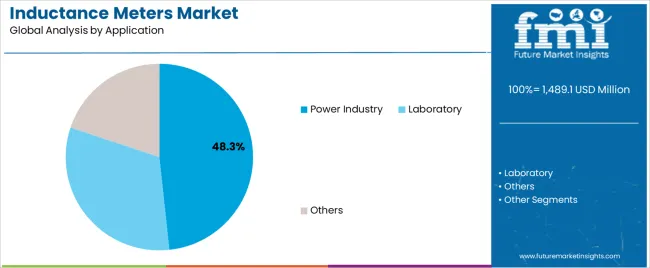
Power industry applications are projected to represent 48.3% of inductance meters demand in 2025, underscoring their critical role as the primary industrial consumers of precision measurement technology for power electronics testing, transformer analysis, and electrical component verification applications. Power industry operators prefer inductance meters for their exceptional measurement accuracy capabilities, reliable performance characteristics, and ability to provide comprehensive component analysis while ensuring effective quality control throughout diverse power electronics manufacturing programs. Positioned as essential equipment for modern power systems operations, inductance meters offer both precision advantages and testing efficiency benefits.
The segment is supported by continuous innovation in high-voltage measurement technologies and the growing availability of specialized testing systems that enable wide-range measurements with enhanced accuracy specifications and rapid component characterization capabilities. Power industry operators are investing in automated testing systems to support large-scale meter utilization and quality control planning. As power electronics demand becomes more prevalent and testing precision requirements increase, power industry applications will continue to dominate the end-use market while supporting advanced measurement automation utilization and component verification strategies.
The inductance meters market is advancing steadily due to increasing demand for precision measurement technologies and growing adoption of automated testing solutions that provide superior measurement accuracy and operational efficiency while enabling comprehensive component characterization across diverse electronics manufacturing and laboratory research applications. The inductance meters market faces challenges, including high-precision instrument costs, calibration maintenance requirements, and the need for specialized operator training and measurement expertise programs. Innovation in digital measurement capabilities and IoT-enabled testing systems continues to influence product development and market expansion patterns.
The growing adoption of digital signal processing, automated measurement systems, and computer-controlled testing algorithms is enabling manufacturers to produce advanced inductance meters with superior measurement capabilities, enhanced operational precision, and automated component characterization functionalities. Advanced digital systems provide improved measurement accuracy while allowing more efficient testing workflows and consistent performance across various component types and measurement conditions. Manufacturers are increasingly recognizing the competitive advantages of automated measurement capabilities for operational differentiation and premium market positioning.
Modern inductance meter producers are incorporating network connectivity, cloud-based data storage, and integrated measurement management systems to enhance operational intelligence, enable predictive maintenance capabilities, and deliver value-added solutions to electronics manufacturing customers. These technologies improve testing efficiency while enabling new operational capabilities, including real-time measurement monitoring, data analysis tracking, and reduced operational overhead. Advanced connectivity integration also allows manufacturers to support comprehensive quality management systems and manufacturing modernization beyond traditional manual testing approaches.
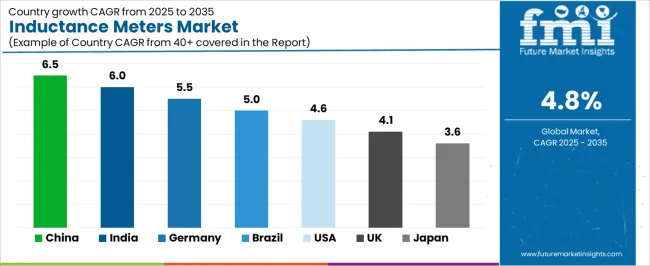
| Country | CAGR (2025-2035) |
|---|---|
| China | 6.5% |
| India | 6.0% |
| Germany | 5.5% |
| Brazil | 5.0% |
| USA | 4.6% |
| UK | 4.1% |
| Japan | 3.6% |
The inductance meters market is experiencing steady growth globally, with China leading at a 6.5% CAGR through 2035, driven by the expanding electronics manufacturing sector, growing precision testing adoption, and significant investment in measurement technology development. India follows at 6.0%, supported by government initiatives promoting manufacturing excellence, increasing industrial automation demand, and growing electronics component production requirements. Germany shows growth at 5.5%, emphasizing precision measurement innovation and advanced manufacturing technology development. Brazil records 5.0%, focusing on industrial expansion and manufacturing automation modernization. The USA demonstrates 4.6% growth, prioritizing measurement accuracy standards and testing automation excellence. The UK exhibits 4.1% growth, emphasizing manufacturing technology adoption and precision measurement development. Japan shows 3.6% growth, supported by high-tech manufacturing initiatives and precision instrumentation concentration.
The report covers an in-depth analysis of 40+ countries, Top-performing countries are highlighted below.
Revenue from inductance meters in China is projected to exhibit strong growth with a CAGR of 6.5% through 2035, driven by expanding electronics manufacturing sector and rapidly growing precision testing adoption supported by government initiatives promoting industrial modernization and manufacturing technology development. The country's strong position in electronics production and increasing investment in quality control infrastructure are creating substantial demand for advanced inductance meter solutions. Major electronics manufacturers and testing facilities are establishing comprehensive measurement capabilities to serve both domestic component production demand and export manufacturing markets.
Revenue from inductance meters in India is expanding at a CAGR of 6.0%, supported by the country's growing electronics manufacturing sector, expanding government support for industrial modernization, and increasing adoption of precision testing solutions. The country's initiatives promoting manufacturing excellence and growing engineering awareness are driving requirements for advanced measurement capabilities. International suppliers and domestic manufacturers are establishing extensive production and service capabilities to address the growing demand for inductance meter products.
Revenue from inductance meters in Germany is expanding at a CAGR of 5.5%, supported by the country's advanced precision manufacturing capabilities, strong emphasis on measurement technology innovation, and robust demand for high-performance testing automation in electronics production and industrial measurement applications. The nation's mature manufacturing sector and efficiency-focused operations are driving sophisticated inductance meter systems throughout the industrial sector. Leading manufacturers and technology providers are investing extensively in digital measurement systems and precision testing technologies to serve both domestic and international markets.
Revenue from inductance meters in Brazil is growing at a CAGR of 5.0%, driven by the country's expanding industrial sector, growing manufacturing operations, and increasing investment in quality control technology development. Brazil's industrial modernization and commitment to manufacturing excellence are supporting demand for efficient inductance meter solutions across multiple electronics production segments. Manufacturers are establishing comprehensive service capabilities to serve the growing domestic market and industrial development opportunities.
Revenue from inductance meters in the USA is expanding at a CAGR of 4.6%, supported by the country's advanced manufacturing technology sector, strategic focus on quality excellence, and established precision measurement capabilities. The USA's measurement innovation leadership and technology integration are driving demand for inductance meters in electronics manufacturing, aerospace testing, and industrial measurement applications. Manufacturers are investing in comprehensive technology development to serve both domestic manufacturing markets and international specialty applications.
Revenue from inductance meters in the UK is growing at a CAGR of 4.1%, driven by the country's focus on manufacturing technology advancement, emphasis on quality excellence, and strong position in precision measurement development. The UK's established manufacturing innovation capabilities and commitment to industrial modernization are supporting investment in advanced measurement technologies throughout major industrial regions. Industry leaders are establishing comprehensive technology integration systems to serve domestic manufacturing operations and specialty testing applications.
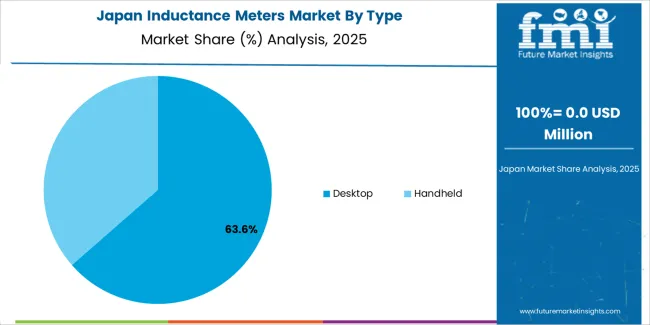
Revenue from inductance meters in Japan is expanding at a CAGR of 3.6%, supported by the country's high-tech manufacturing initiatives, growing precision instrumentation sector, and strategic emphasis on measurement technology development. Japan's advanced technology capabilities and integrated manufacturing systems are driving demand for advanced inductance meters in automotive electronics, precision manufacturing, and high-value industrial applications. Leading manufacturers are investing in specialized capabilities to serve the stringent requirements of high-tech manufacturing and precision testing industries.
The inductance meters market in Europe is projected to grow from USD 298.2 million in 2025 to USD 476.0 million by 2035, registering a CAGR of 4.8% over the forecast period. Germany is expected to maintain its leadership position with a 38.5% market share in 2025, declining slightly to 37.8% by 2035, supported by its strong precision manufacturing sector, advanced measurement technology capabilities, and comprehensive industrial automation industry serving diverse inductance meter applications across Europe.
France follows with a 16.2% share in 2025, projected to reach 16.8% by 2035, driven by robust demand for inductance meters in aerospace manufacturing, automotive electronics testing, and precision manufacturing applications, combined with established industrial technology infrastructure and measurement expertise. The United Kingdom holds a 14.5% share in 2025, expected to reach 15.1% by 2035, supported by strong manufacturing technology sector and growing precision testing activities. Italy commands a 11.8% share in 2025, projected to reach 12.2% by 2035, while Spain accounts for 8.4% in 2025, expected to reach 8.7% by 2035. The Netherlands maintains a 5.2% share in 2025, growing to 5.4% by 2035. The Rest of Europe region, including Nordic countries, Eastern Europe, Belgium, Poland, and other nations, is anticipated to maintain momentum, with its collective share moving from 5.4% to 4.0% by 2035, attributed to increasing manufacturing modernization in Eastern Europe and growing precision testing penetration in Nordic countries implementing advanced measurement technology programs.
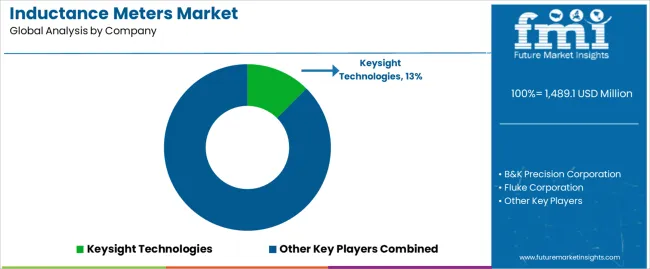
The inductance meters market is characterized by competition among established test equipment manufacturers, specialized measurement instrument producers, and integrated testing solutions providers. Companies are investing in digital measurement technology research, accuracy optimization, precision testing system development, and comprehensive product portfolios to deliver consistent, high-performance, and application-specific inductance meter solutions. Innovation in automated measurement systems, connectivity integration, and operational efficiency enhancement is central to strengthening market position and competitive advantage.
Keysight Technologies leads the inductance meters market with a strong market share, offering comprehensive inductance meter solutions, including advanced measurement systems with a focus on electronics and industrial applications. B&K Precision Corporation provides specialized precision measurement capabilities with an emphasis on laboratory and manufacturing testing systems. Fluke Corporation delivers innovative measurement products with a focus on industrial applications and field measurement requirements. Hioki specializes in precision electrical measurement and testing technologies for electronics manufacturing applications. Extech Instruments (FLIR) focuses on portable measurement equipment and integrated testing solutions. IET Labs offers specialized laboratory instruments with emphasis on precision measurement and calibration applications.
| Items | Values |
|---|---|
| Quantitative Units (2025) | USD 1,489.1 million |
| Type | Desktop, Handheld |
| Application | Power Industry, Laboratory, Others |
| End-Use Sector | Electronics Manufacturing, Research Institutions, Automotive, Aerospace, Telecommunications |
| Frequency Range | Low Frequency (20Hz-100kHz), Medium Frequency (100kHz-1MHz), High Frequency (1MHz-10MHz) |
| Regions Covered | North America, Europe, East Asia, South Asia & Pacific, Latin America, Middle East & Africa |
| Countries Covered | China, India, Germany, Brazil, United States, United Kingdom, Japan and 40+ countries |
| Key Companies Profiled | Keysight Technologies, B&K Precision Corporation, Fluke Corporation, Hioki, Extech Instruments (FLIR), and IET Labs |
| Additional Attributes | Dollar sales by type and application category, regional demand trends, competitive landscape, technological advancements in digital measurement systems, precision testing development, IoT integration innovation, and manufacturing automation integration |
The global inductance meters market is estimated to be valued at USD 1,489.1 million in 2025.
The market size for the inductance meters market is projected to reach USD 2,379.7 million by 2035.
The inductance meters market is expected to grow at a 4.8% CAGR between 2025 and 2035.
The key product types in inductance meters market are desktop and handheld.
In terms of application, power industry segment to command 48.3% share in the inductance meters market in 2025.






Full Research Suite comprises of:
Market outlook & trends analysis
Interviews & case studies
Strategic recommendations
Vendor profiles & capabilities analysis
5-year forecasts
8 regions and 60+ country-level data splits
Market segment data splits
12 months of continuous data updates
DELIVERED AS:
PDF EXCEL ONLINE
Ammeters Market Size and Share Forecast Outlook 2025 to 2035
Ergometers Market Size and Share Forecast Outlook 2025 to 2035
Rheometers Market Size and Share Forecast Outlook 2025 to 2035
LCR Meters Market Analysis - Size, Share, and Forecast Outlook 2025 to 2035
Gas Meters Market Growth - Trends & Forecast 2025 to 2035
Manometers Market
Micrometers Market Size and Share Forecast Outlook 2025 to 2035
Viscometers Market Size and Share Forecast Outlook 2025 to 2035
Flow Meters Market Growth - Trends & Forecast 2025 to 2035
Megohmmeters Market Size and Share Forecast Outlook 2025 to 2035
Calorimeters Market Size and Share Forecast Outlook 2025 to 2035
Gloss Meters Market
Luminometers Market
Refractometers Market Growth – Trends & Forecast 2018-2027
Turbidity Meters Market Size and Share Forecast Outlook 2025 to 2035
Pocket Pedometers Market
Dial Thermometers Market
Spectrophotometers Market Size and Share Forecast Outlook 2025 to 2035
Bone Densitometers Analysis by Product Type, by Technology and by End User through 2035
Resistivity Meters Market

Thank you!
You will receive an email from our Business Development Manager. Please be sure to check your SPAM/JUNK folder too.
Chat With
MaRIA